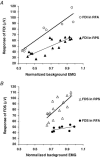Phase-dependent and task-dependent modulation of stretch reflexes during rhythmical hand tasks in humans
- PMID: 15746170
- PMCID: PMC1464471
- DOI: 10.1113/jphysiol.2004.082271
Phase-dependent and task-dependent modulation of stretch reflexes during rhythmical hand tasks in humans
Abstract
Phase-dependent and task-dependent modulation of reflexes has been extensively demonstrated in leg muscles during locomotory activity. In contrast, the modulation of reflex responses of hand muscles during rhythmic movement is poorly documented. The objective of this study was to determine whether comparable reflex modulation occurs in muscles controlling finger motions during rhythmic, fine-motor tasks akin to handwriting. Twelve healthy subjects performed two rhythmic tasks while reflexes were evoked by mechanical perturbations applied at various phases of each task. Electromyograms (EMGs) were recorded from four hand muscles, and reflexes were averaged during each task relative to the movement phase. Stretch reflexes in all four muscles were found to be modulated in amplitude with respect to the phase of the rhythmic tasks, and also to vary distinctly with the tasks being conducted. The extent and pattern of reflex modulation differed between muscles in the same task, and between tasks for the same muscle. Muscles with a primary role in each task showed a higher correlation between reflex response and background EMG than other muscles. The results suggest that the modulation patterns observed may reflect optimal strategies of central-peripheral interactions in controlling the performance of fine-motor tasks. As with comparable studies on locomotion, the phase-dependency of the stretch reflexes implies a dynamically fluctuating role of proprioceptive feedback in the control of the hand muscles. The clear task-dependency is also consistent with a dynamic interaction of sensory feedback and central programming, presumably adapted to facilitate the successful performance of the different fine-motor tasks.
Figures






Similar articles
-
Modulation of reflex responses in hand muscles during rhythmical finger tasks in a subject with writer's cramp.Exp Brain Res. 2007 Mar;177(4):573-8. doi: 10.1007/s00221-007-0880-9. Epub 2007 Feb 16. Exp Brain Res. 2007. PMID: 17323105
-
Neural regulation of rhythmic arm and leg movement is conserved across human locomotor tasks.J Physiol. 2007 Jul 1;582(Pt 1):209-27. doi: 10.1113/jphysiol.2007.133843. Epub 2007 Apr 26. J Physiol. 2007. PMID: 17463036 Free PMC article.
-
Neural control of rhythmic human arm movement: phase dependence and task modulation of hoffmann reflexes in forearm muscles.J Neurophysiol. 2003 Jan;89(1):12-21. doi: 10.1152/jn.00416.2002. J Neurophysiol. 2003. PMID: 12522155
-
Possible contributions of CPG activity to the control of rhythmic human arm movement.Can J Physiol Pharmacol. 2004 Aug-Sep;82(8-9):556-68. doi: 10.1139/y04-056. Can J Physiol Pharmacol. 2004. PMID: 15523513 Review.
-
Contributions to the understanding of gait control.Dan Med J. 2014 Apr;61(4):B4823. Dan Med J. 2014. PMID: 24814597 Review.
Cited by
-
The Dynamics of Voluntary Force Production in Afferented Muscle Influence Involuntary Tremor.Front Comput Neurosci. 2016 Aug 19;10:86. doi: 10.3389/fncom.2016.00086. eCollection 2016. Front Comput Neurosci. 2016. PMID: 27594832 Free PMC article.
-
Modulation of reflex responses in hand muscles during rhythmical finger tasks in a subject with writer's cramp.Exp Brain Res. 2007 Mar;177(4):573-8. doi: 10.1007/s00221-007-0880-9. Epub 2007 Feb 16. Exp Brain Res. 2007. PMID: 17323105
-
Bilateral coupling facilitates recovery of rhythmical movements from perturbation in healthy and post-stroke subjects.Exp Brain Res. 2013 Jun;227(2):263-74. doi: 10.1007/s00221-013-3509-1. Epub 2013 Apr 23. Exp Brain Res. 2013. PMID: 23609831
-
From spontaneous motor activity to coordinated behaviour: a developmental model.PLoS Comput Biol. 2014 Jul 24;10(7):e1003653. doi: 10.1371/journal.pcbi.1003653. eCollection 2014 Jul. PLoS Comput Biol. 2014. PMID: 25057775 Free PMC article.
References
-
- Belanger M, Patla AE. Phase-dependent compensatory responses to perturbation applied during walking in humans. J Mot Behav. 1987;19:434–453. - PubMed
-
- Brooke JD, Cheng J, Collins DF, McIlroy WE, Misiaszek JE, Staines WR. Sensori-sensory afferent conditioning with leg movement: gain control in spinal reflex and ascending paths. Prog Neurobiol. 1997;51:393–421. - PubMed
-
- Brooke JD, Cheng J, Misiaszek JE, Lafferty K. Amplitude modulation of the soleus H reflex in the human during active and passive stepping movements. J Neurophysiol. 1995;73:102–111. - PubMed
-
- Brooke JD, Peritore G, Staines WR, McIlroy WE, Nelson A. Upper limb H reflexes and somatosensory evoked potentials modulated by movement. J Electromyogr Kinesiol. 2000;10:211–215. - PubMed
Publication types
MeSH terms
LinkOut - more resources
Full Text Sources
Research Materials

